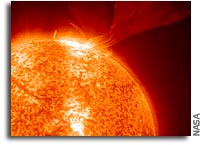Protecting Astronauts from Solar Storms

With the impending solar maximum expected to bring heightened rates of flares and coronal mass ejections (CMEs), putting at risk an ever-increasing human presence in space, Oh et al. designed and assessed a prediction system to keep astronauts safe from these solar storms.
During a solar flare or CME, particles from the Sun can be accelerated to very high energies-in some cases travelling near the speed of light. Protons with energies surpassing 100 megaelectron volts essentially sandblast everything in their path. Though people on Earth are protected by the planet’s magnetic field and thick atmosphere, astronauts in spacecraft beyond low-Earth orbit, or people at high altitudes near the poles, can be exposed to this increased radiation. This can potentially cause radiation sickness, with symptoms such as fever and vomiting.
The authors’ prediction system uses two different types of neutron detectors installed at the geographic south pole to measure the intensity of the much faster gigaelectron volt neutrons also produced during a solar storm when protons interact with the atmosphere. By combining the observations of the two detectors — one located outside, and the other housed inside, the Amundsen-Scott South Pole Station –the authors calculated the energy spectrum of the arriving protons. They then extrapolated this spectrum to estimate the peak intensity and event-averaged flux (fluence) of the later-arriving megaelectron volt protons. The authors compared their predictions for 12 solar events against observations made by geosynchronous satellites, finding a good agreement for intensity and fluence predictions for protons with energies higher than 40 and 80 megaelectron volts, respectively. The system provides a warning time of up to 166 minutes, depending on the protons’ energy, giving polar airplanes or astronauts ample time to reduce their altitude or seek out an armored area in their spacecraft.
Source: Space Weather, doi:10.1029/2012SW000795, 2012 http://dx.doi.org/10.1029/2012SW000795
Title: “South Pole neutron monitor forecasting of solar proton radiation intensity”
Authors: S. Y. Oh: Department of Astronomy and Space Science, Chungnam National University, Daejeon, South Korea and Bartol Research Institute, Department of Physics and Astronomy, University of Delaware, Newark, Delaware, USA; J. W. Bieber, J. Clem, P. Evenson, and R. Pyle: Bartol Research Institute, Department of Physics and Astronomy, University of Delaware, Newark, Delaware, USA; Y. Yi: Department of Astronomy and Space Science, Chungnam National University, Daejeon, South Korea; Y.-K. Kim: Department of Nuclear Engineering, Hanyang University, Seoul, South Korea.
Contact:
Kate Ramsayer
+1 202 777 7524
kramsayer@agu.org








